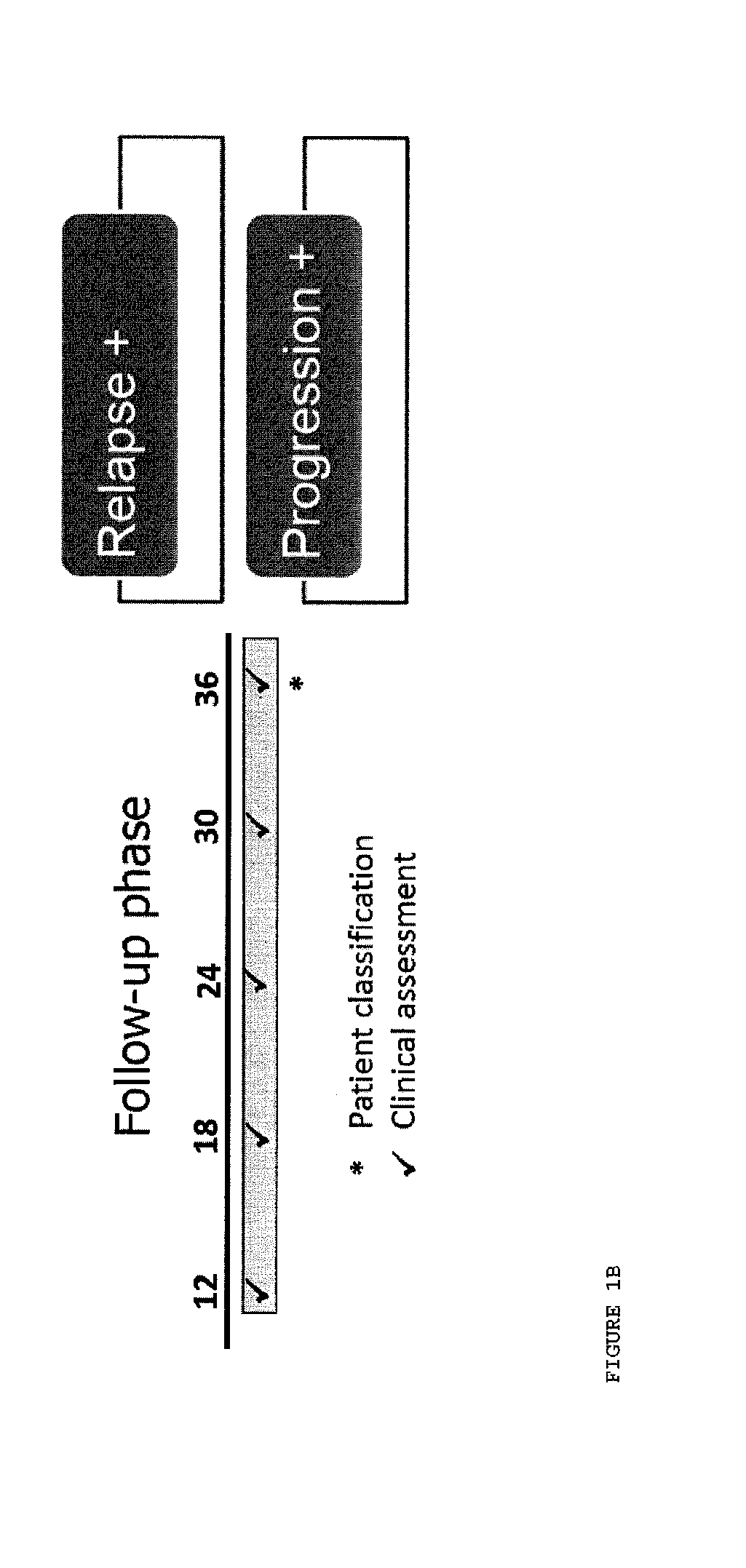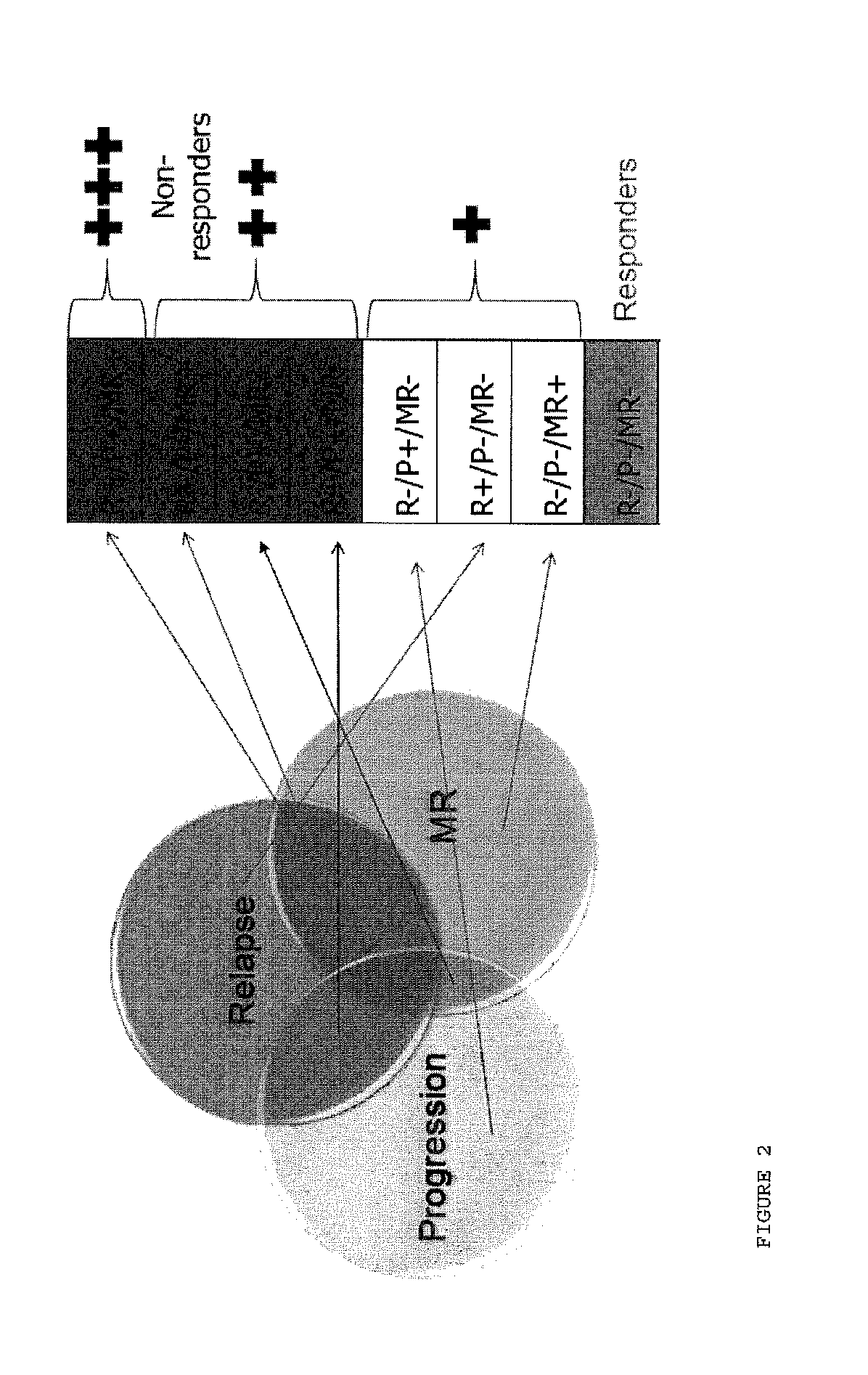Biomarkers predictive for clinical response for glatiramer acetate
a technology of glatiramer acetate and biomarkers, which is applied in the direction of drug compositions, peptide/protein ingredients, library screening, etc., can solve the problems of not all treated patients respond to ga to the same degree, and the mechanism of action of ga has not been fully elucidated
- Summary
- Abstract
- Description
- Claims
- Application Information
AI Technical Summary
Problems solved by technology
Method used
Image
Examples
example 1
Identification of Patients as Responders and GA Non-Responders is Indicative of Future Activity
[0107]During a run-in phase, patients were evaluated at baseline, 3 months, 6 months and 12 months and were scored positive or negative on the basis of three criteria: relapse, disease progression, and MRI evaluation (FIG. 1a). During the Follow-up phase patients were evaluated at 12 months, 18 months, 24 months, 30 months and 36 months and were scored positive or negative on the basis of two criteria: relapse and disease progression (FIG. 1b). Table 1 shows odds ratio, confidence limits and significance of follow-up phase progression in patients having one, two or three positive variables during run-in phase classification (33).
TABLE 1Risk of activity during the period of follow-up (months 12-36) according to the positivity for the different variables after12 months of therapy.
example 2
Identification of Patients as GA Responders and Non-Responders
[0108]Similar to Example 1, above, patients were treated with glatiramer acetate and evaluated at baseline, 3 months, 12 months and 24 months after beginning treatment with glatiramer acetate and were scored positive or negative on the basis of three criteria: relapse, disease progression, and MRI evaluation (FIG. 2). Patients scoring positive in at least two variables were classified as Non-Responders while those scoring negative in all three variables were classified as Responders.
TABLE 2Characteristics of patient subgroups.CharacteristicsRespondersNon-respondersHCN6914Age (years)a30.2(5.8)36.4(8.6)29.9(4.7)Female / male6 / 0(100.0)6 / 3(66.7)10 / 4(71.4)(% women)Duration of5.7(3.7)8.4(5.4)—disease (years)aEDSSb1.5(1.5-1.5)2.1(1.3-2.8)—in Number of2.0(0)2.6(0.5)—relapses the twoprevious yearsaaData are expressed as mean (standard deviation).bData are expressed as mean (interquartile range).HC: healthy controls
example 3
Identification of Differentially Expressed Genes in Patients Identified as Responders Versus Non-Responders
Methods
Subjects and Cells:
[0109]Relapsing-remitting multiple sclerosis patients were treated with GA. Whole blood was taken from patients at four time points including baseline (baseline, month 3, month 12 and month 24). Peripheral blood mononuclear cells (PBMCs) were cryopreserved and RNA was isolated for gene expression analysis (FIG. 3).
Gene Expression Analysis
[0110]Gene expression analysis was performed using Affymetrix Human Exon 1.0 ST expression arrays. Preprocessing was performed with an integrated three-step approach: background correction, normalization (iterPLER), and summarization (Sketch-Quantile) implemented in the Affymetrix Expression Console. Batch effects normalization was performed with the removeBatchEffect function from limma R package.
[0111]The selection of differentially expressed genes (DEG) between responders and non-responders at baseline was based on ...
PUM
| Property | Measurement | Unit |
|---|---|---|
| molecular weight | aaaaa | aaaaa |
| molecular weight | aaaaa | aaaaa |
| time | aaaaa | aaaaa |
Abstract
Description
Claims
Application Information
 Login to view more
Login to view more - R&D Engineer
- R&D Manager
- IP Professional
- Industry Leading Data Capabilities
- Powerful AI technology
- Patent DNA Extraction
Browse by: Latest US Patents, China's latest patents, Technical Efficacy Thesaurus, Application Domain, Technology Topic.
© 2024 PatSnap. All rights reserved.Legal|Privacy policy|Modern Slavery Act Transparency Statement|Sitemap



